Songkran 2018: How to celebrate Thai New Year at home with traditional dishes
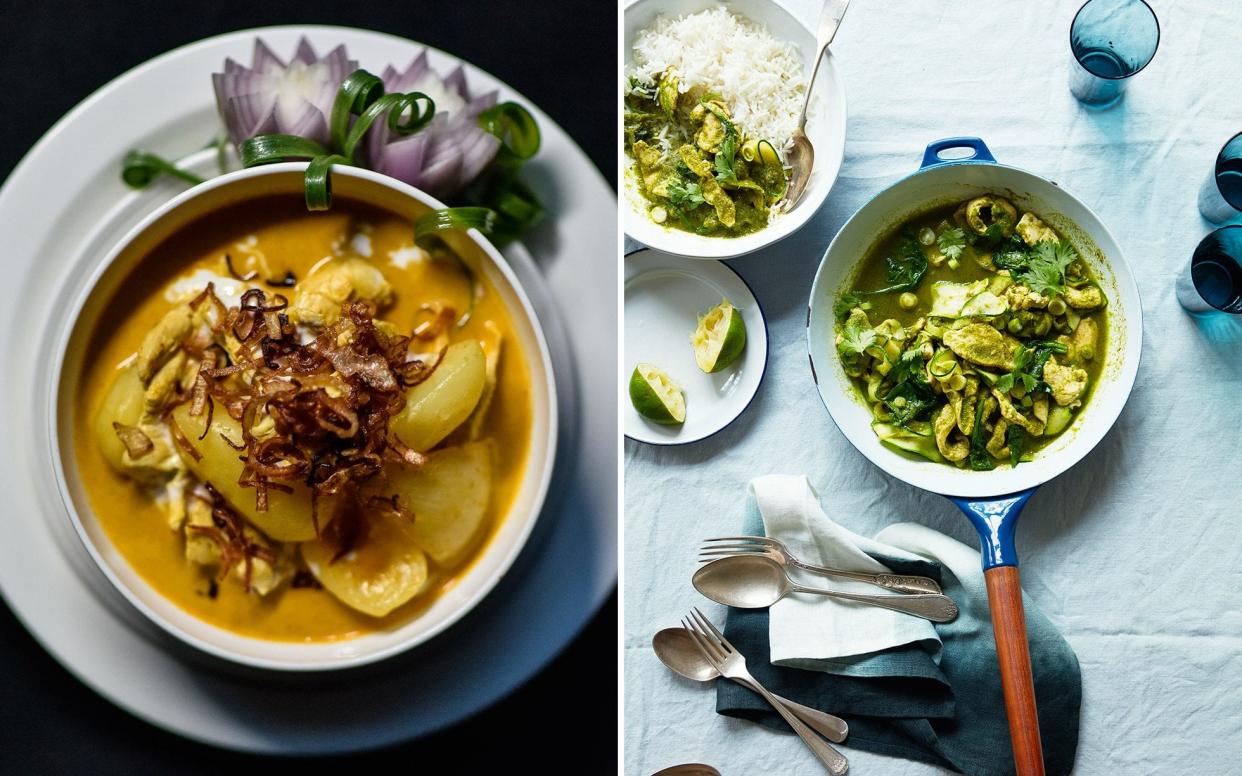
Songkran is an annual three-day water festival which celebrates the Thai New Year with the ceremonial sprinkling of water. The Sanskrit word 'Songkran' translates as "passing", and refers to transformation and change.
It falls from Friday 13 April to Sunday 15 April, and is an important fixture in the Buddhist calendar during which friends and family gather for food and festivities all over Thailand - culminating in a glorious country-wide water fight.
But if you fear you're missing out on the fun this weekend here in the UK, fear not: there's nothing to say you can't mark the occasion with a feast of Thai cuisine, featuring a delicate balance of flavour from traditional Thai ingredients such as lime leaves, tamarind, shrimp paste, coconut, palm sugar and chillies.
To mark the occasion, Sanguan Parr (head chef at Nipa Thai at London's Royal Lancaster hotel) shares her recipe below for massaman gai, a rich, mild recipe for yellow chicken curry from the southern region of Thailand - and we round up some of our other favourite Thai recipes from our columnists for further inspiration, too.
Massaman gai
Surprisingly simple to make but guaranteed to impress, Sanguan Parr's massaman gai is the perfect dish for your Songkran celebrations.
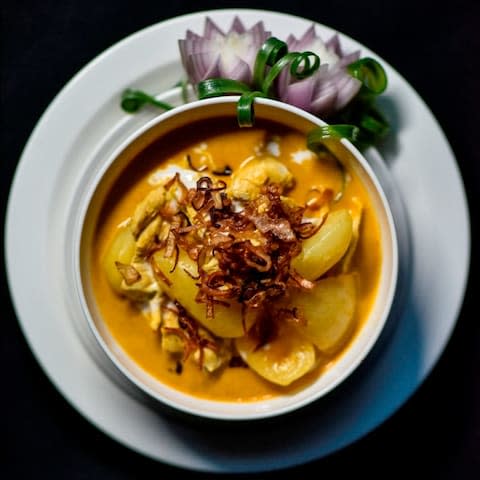
SERVES 4
INGREDIENTS
2 chicken breasts
600ml coconut milk
2 tbsp roasted peanuts
5 small onions, sliced
4 medium potatoes; cubed
3 tbsp Massaman curry paste
2 tbsp fish sauce
3 tbsp palm sugar
3 tbsp tamarind juice
3 bay leaves
1 piece roasted cinnamon; 1cm long
5 roasted cardamom pods
1 tbsp vegetable oil
METHOD
Cut the chicken into chunks, around 2 inches in length.
In a wok, heat the vegetable oil, curry paste and 200ml of coconut milk.
Keep stirring over a low heat until fragrant.
Add the chicken to the wok, turning frequently so all the meat is covered in sauce.
Pour in the remaining 400ml of coconut milk and simmer gently for 5 minutes.
Add the cubed potatoes, roasted peanuts, onions, fish sauce, palm sugar, tamarind juice, bay leaves, cardamom and cinnamon. Keep over a low heat to simmer until all the ingredients are tender.
Remove from the heat and serve with steamed white rice.
Stephen Harris' Thai green vegetable curry
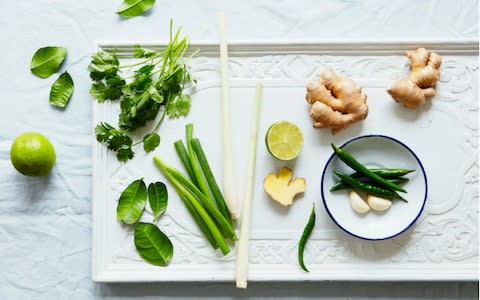
SERVES 4
INGREDIENTS
1 medium bunch of coriander (a few leaves reserved for a garnish)
2 sticks lemongrass, finely chopped
2 cloves garlic, peeled
2.5cm knob of root ginger, peeled and roughly chopped
4 small green chillies, or more if you like it hotter
2 lime leaves, if you can get your hands on them
Bunch of spring onions, chopped and separated into green and white parts
1 bag baby spinach, around 100g
1 tbsp fish sauce
1 x 400ml tin coconut milk
1 lime
3 large skinless chicken breasts
Oil for frying
2 medium courgettes
METHOD
Place the coriander, lemongrass, garlic, ginger, chillies and lime leaves in a blender with the green parts of the spring onions and a third of the spinach. Add the fish sauce, coconut milk and the juice of half the lime. Blitz this together until you have a bright green, fragrant sauce; set aside.
Slice the chicken breasts widthways into thin strips about 1cm thick.
Slice the courgettes lengthways into very thin strips, using a mandolin if you have one.
In a large frying pan, fry the chicken in a little oil until the strips are starting to colour (about three minutes), then add the courgettes. Cook together for a minute and then add in the green sauce.
Cook rapidly for two minutes and then stir in the remaining spinach. Cook for one more minute and check the chicken is cooked through.
Now throw in the reserved white spring onion, the reserved coriander and the juice of half a lime and stir everything into the curry. Add a little salt if needed, before serving with rice.
Stevie Parle's Pad Thai recipe
The key to this is to have the ingredients prepared and ready to go so you can work quickly.
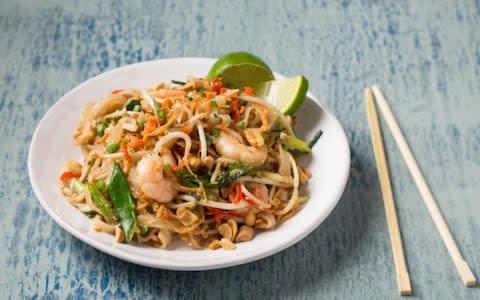
SERVES 4
50ml/2fl oz tamarind water
40ml/1½fl oz fish sauce
30g/1oz palm sugar or 2 tbsp caster sugar
200g/7oz wide flat rice noodles
Vegetable oil
16 large prawns, peeled or unpeeled
4 spring onions, sliced
2 garlic cloves, finely sliced
1 red chilli, deseeded, finely sliced
2 eggs
100g/4oz bean sprouts
4 stalks Chinese chives, chopped
2 handfuls of peanuts, roasted and chopped
Lime wedges, to serve
METHOD
Combine the tamarind, fish sauce and sugar and heat gently until the sugar dissolves. Put to one side for a moment.
Bring a pan of water to the boil, pour over the noodles and leave for 15 minutes until tender. Rinse under cold water until the water runs clear.
Place a wok or large frying pan over a high heat and add a small splash of oil.
Stir-fry the prawns for a couple of minutes until they begin to colour and are cooked through but still juicy. Remove from the pan for a moment.
Add another splash of oil to the pan and add the spring onions, garlic and chilli and stir-fry for few moments until the onions wilt, then stir in the noodles and the tamarind sauce.
Return the prawns to the pan, then push everything to the side and crack in the eggs. Break the yolks and scramble them as they start turning opaque.
Stir the egg through the noodles and add the bean sprouts, chives and peanuts. Stir-fry until well combined, then serve with lime wedges.
Diana Henry's Thai stir-fried minced beef with basil and chilli
This is hot, hot, hot but you can leave out some of the chillis if you want to. Waitrose now do Thai basil, though the recipe should really be made with holy basil (and you can only get that in specialist Asian shops). This is served with a deep-fried egg on top and it’s a lovely addition – it mollifies the heat for a start, and deep-frying the egg makes it puff up into a gorgeous crispy edged cloud – but you can just do regular fried eggs instead.
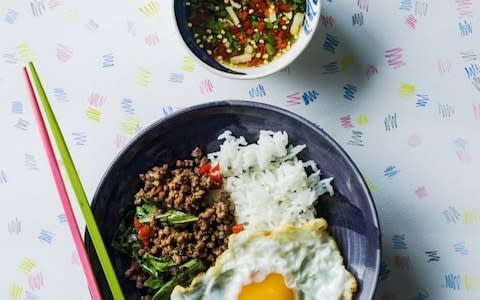
SERVES 2
INGREDIENTS
For the sauce
35ml fish sauce
2 bird’s-eye chillies, finely sliced
1 garlic clove, very finely sliced
1 tbsp lime juice
1 tsp coriander, finely chopped
For the beef
6 red or green bird’s eye chillies (fewer if you want it less hot)
4 small garlic cloves
3 tbsp vegetable oil, plus more for deep-frying the eggs
200g good-quality, coarsely minced beef
good pinch of caster sugar
about 2 tbsp fish sauce
big handful of Thai basil (or holy basil from specialist Asian shops)
2 large eggs
METHOD
For the serving sauce, mix together the fish sauce, chillies and garlic and set aside for the flavours to meld.
Meanwhile, for the beef, coarsely chop the chillies with the garlic and a pinch of salt.
Heat about 10cm of oil in a saucepan (for the deep-fried eggs) while you cook the beef. (Though if you prefer, you can shallow-fry the eggs in a regular frying pan.)
Heat 3 tbsp of oil in a wok then fry the garlic and chilli mixture, but don’t let it colour. Add the beef and stir-fry for a minute, until only just cooked.
Season to taste with the sugar and fish sauce but be careful not to make it too salty. Add 50ml water and gently simmer for a minute, but don’t let it boil or the meat will become tough. There should be enough liquid to make a bit of a sauce.
Stir in the basil and remove from the heat.
Fry your eggs. To deep-fry, have the oil really hot and crack in an egg so it’s submerged. Fry until the white is crispy and the yolk still runny (it should take less than a minute). Drain well.
Add the lime and coriander to the sauce and serve alongside the beef with boiled rice and a fried egg on top of each dish.
Three of the best wines to serve with a Thai curry

